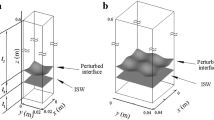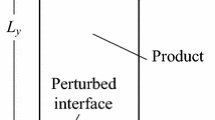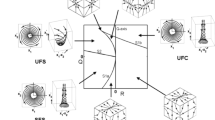Abstract
This paper discusses the progress of premixed flames after undergoing strong interactions with pressure driven disturbances. Even in one dimensional models of these interactions, if a pressure drop is fast enough and sufficiently great, extinction of the flame can result.
For two-dimensional interactions, a further very important mechanism is the baroclinic effect where the force due to the imposed pressure gradient acts on a region of fluid with variable density (i.e. the flame) which is at an angle to it, thus producing a vorticity field which can break up the flame. This was clearly demonstrated by the classic experimental work of Markstein. An overview is presented of recent numerical work that shows the dependence of the vorticity generated in the fluid on the viscosity and the strength of the reaction.
Preview
Unable to display preview. Download preview PDF.
Similar content being viewed by others
References
Toepler, A., Ann. Physics. Leipzig, 128, 126-., 1866.
Rayleigh, Lord, Theory of Sounds, Macmillan, London, 1896.
Gaydon, A.G. and Wolfhard, H. G., Flames, Their structure, radiation and temperature, 3rd Ed., Chapnam and Hall, London., 1970.
Strehlow, R.A., Combustion Fundamentals, McGraw-Hill, New York, 1988.
Gardner, C.L., Glimm, J., Grove, J.W., McBryan, O., Zhang, Q., Menkoff, R. and Sharp, D.H., “A study of chaos and mixing in Rayleigh-Taylor and Richtmeyer-Meshkov unstable interfaces”, Nuclear Physics B (Proc. Suppl.) 2, 441–452., 1987
Cloutman, L.D. and Wehner, M.F., “Numerical simulation of RichtmeyerMeshkov instabilities”, Phys. Fluids A 4(8), 1821–1830, 1992.
Markstein, G.H., Non-steady, flame propagation, AGARDograph 75, Pergamon, Oxford, 1964.
Picone, J.M., Oran, E.S., Boris, J.P. and Young, T.R., “Theory of vorticity generation by shock wave and flame interactions”, Prog. in Astronautics and Aeronautics: Dynamics of Shock waves, explosions and detonations. 94, 429–448, 1984.
Batley G.A., McIntosh A.C., Brindley J. and Falle S.A.E.G., “A numerical study of the vorticity field generated by the baroclinic effect due to the propagation of a planar pressure wave through a cylindrical premixed laminar flame”, Jnl. Fluid Mech. 279, 217–237, Nov. 1994.
Batley, G.A., McIntosh A.C. and Brindley J., “Baroclinic distortion of laminar flames”, (submitted to Proc. Roy. Soc. A July 1994).
Clarke, J.F., “Fast flames, waves and detonation”, Prog. Energy Combust. Sci. 15. 241–271 1989.
Tsuruda T. and Hirano T., “Local Flame Disturbance Development under Acceleration”, Contb. and Flame. 84, 66–72, 1991.
Liu, F., McIntosh. A.C. and Brindley, J., “A Numerical Investigation of Rayleigh-Taylor Effects in Pressure Wave-Premixed Flame Interactions”, Comb. Sci. and Tech. 91(4–6), 373–386, 1993.
Edwards, N.R., McIntosh A.C., and Brindley, J., “The development of pressure induced instabilities in premixed flames”, Comb. Sci. and Tech., 99(1–3), 179–200, 1994.
Cooper, M.G., Fairweather, M. and Tite, J.P., “On the mechanisms of pressure generation in vented explosions”, Comb. and Flame 65, 1–14, 1986.
McIntosh, A.C., “The influence of pressure waves in the early stages of explosions”, AIAA 94-0104, 32nd Aerospace Sciences Meeting & Exhibit Jan. 10–13 1994, Reno, NV, USA, 1994.
McIntosh, A.C., “Pressure Disturbances of Different Lengthscales Interacting with Conventional Flames”, Comb. Sci. Tech. 75, 287–309, 1991.
McIntosh, A.C., “The linearised response of the mass burning rate of a premixed flame to rapid pressure changes”, Comb. Sci. and Tech. 91(4–6), 329–346, 1993.
Batley, G., McIntosh, A.C. and Brindley, J., “The time. evolution of interactions between short lengthscale pressure disturbances and premixed flames”, Comb. Sci. and Tech. 92, 367–388, 1993.
Johnson, R.G., McIntosh A.C., Batley G.A. and Brindley J., “Nonlinear oscillations of premixed flames caused by sharp pressure changes”, Comb. Sci. and Tech. 99(1–3), 201, 1994.
Johnson, R. G., McIntosh A. C. and Brindley J., "Extinction of premixed flames by pressure drops”, Comb. and Flame (submitted March 1994).
Johnson, R.G.and McIntosh A.C., “On the phenomenon of local flow reversal in a premixed flame due to a large pressure pulse”, Comb. Sci. and Tech.. (submitted May 1994).
Ledder, G. and Kapila, A.K., “The Response of Premixed Flames to Pressure Perturbations”, Comb. Sci and Tech. 76, 21–44, 1991.
Clarke, J.F., “On changes in the structure of steady plane flames as their speed increases”, Comb. and Flame. 50, 125–138, 1983.
Clarke, J.F., “Combustion in plane steady compressible flow: general considerations and gasdynamical adjustment regions”, Jnl. Fluid Mech. 136, 139–166, 1983.
Clarke, J.F., “Chemical reactions in high-speed flows”, Phil. Trans. R. Soc. Lond. A 335, 161–199, 1991.
Clarke, J.F. and Cant, R.S., “Non-steady gas dynamic effects in the induction domain behind a strong shock wave”, Prog. Astronaut. Aeronaut. 95, 142–163, 1984.
Kassoy, D.R. and Clarke, J.F., “The structure of a steady high-speed deflagration with a finite origin”, Jnl. Fluid Mech. 150, 253–280, 1985.
Singh, G. and Clarke, J.F., “Transient phenomena in the initiation of a mechnically driven plane detonation”, Proc. Roy. Soc. A 438, 23–46, 1992.
Blythe, P. and Crighton, D.G., Proc. Roy. Soc. A 426, 189–209, 1989.
Chue, R.S., Clarke, J.F. and Lee, J.H., “Chapman-Jouguet deflagrations”, Proc. Roy. Soc. A 441, 607–623, 1993.
Dold, J.W., Kapila, A.K. and Short M., Dynamic Structure of Detonation in Gaseous and Dispersed Media, Kluwer, 109–141, 1991.
Short, M. and Dold, J.W., Prog. in Astron. and Aeronaut. 154, 59–74, 1993.
Buckmaster, J. D., “The mathematics of combustion”, Frontiers in Applied Mathematics vol 3, SIAM Monograph series in Applied Mathematics, 1985.
Author information
Authors and Affiliations
Editor information
Rights and permissions
Copyright information
© 1995 Springer-Verlag
About this paper
Cite this paper
McIntosh, A.C. (1995). Pressure-driven disturbances in fluid dynamic interactions with flames. In: Buckmaster, J., Takeno, T. (eds) Modeling in Combustion Science. Lecture Notes in Physics, vol 449. Springer, Berlin, Heidelberg. https://doi.org/10.1007/3-540-59224-5_13
Download citation
DOI: https://doi.org/10.1007/3-540-59224-5_13
Published:
Publisher Name: Springer, Berlin, Heidelberg
Print ISBN: 978-3-540-59224-2
Online ISBN: 978-3-540-49226-9
eBook Packages: Springer Book Archive




